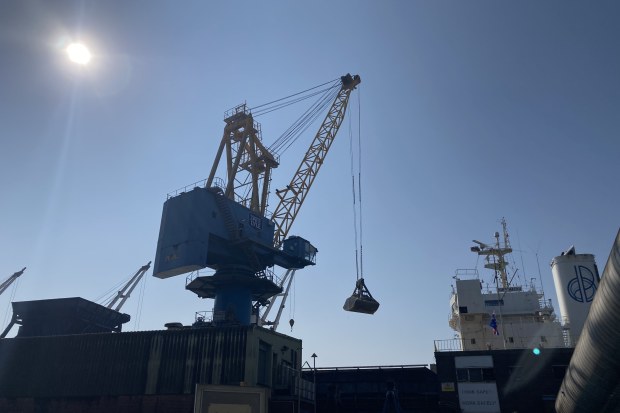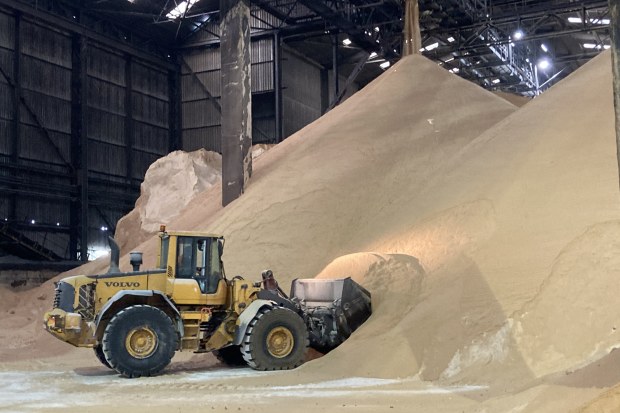How the UK trade deal is giving Aussie farmers a sugar hit

London | On Wednesday evening (Thursday AEST), the cargo ship Port Macao sailed up the Thames River and berthed at the modest wharf beside Tate & Lyle’s sugar refinery – one of the last industrial buildings still standing, and working, in London’s docklands.
It’s not uncommon to see freighters sitting at Tate & Lyle’s wharf, unloading tens of thousands of tonnes of milled sugar into the factory’s cavernous hangars. But the Port Macao was special.

Tate & Lyle’s crane takes sugar from the hold of the freighter Port Macao, docked beside the company’s London refinery. Hans van Leeuwen
Eight weeks earlier, it had sailed out of Queensland with 33,000 tonnes of milled Australian raw cane sugar in its hold, extracted from the Burdekin region south of Townsville.
Any previous shipment from Australia of this size, worth perhaps $35 million, would have attracted a punishing tariff of about $18 million – enough to render it commercially unviable, and to stifle the Australia-UK sugar trade.
But thanks to the two countries’ free trade agreement (FTA), which came into force on May 31, this shipment was tariff-free.
“We’re unloading at the moment, as we speak, the very highest quality raw cane sugar from Queensland, in Australia, in the first vessel that we’ve brought to the United Kingdom under the new free trade agreement,” said Gerard Mason, the effervescent senior vice president of Tate & Lyle Sugars.
Both he and his counterparts at Queensland Sugar Limited hope it will be the first of many, as the FTA expands, and then scraps, the remaining sugar quotas in the coming eight years.

Sugar on barges at the Tate & Lyle refinery in 1922.
This will mark a Brexit-powered renaissance for a historic trade relationship that goes all the way back to early Victorian times, but which dwindled to near extinction in the 20th century’s final decades.
Tate & Lyle, which has been refining sugar at this site for 145 years, has been under the cosh in recent times. It has struggled to get enough raw cane sugar, at the right price, to make enough product and profit.
In the decades after Britain joined the European Economic Community in 1973, Tate & Lyle had to submit to Brussels’ stringent tariff regime for sugar, cutting off the plentiful Australian supply.
The storied company became a shadow of its former self, closing refinery after refinery until the groaning, steaming hulk at Silvertown, in east London, was all that remained.
Things got even worse in 2017, when the European Union tilted the playing field towards cane sugar’s rival, the domestically grown sugar beet.
But Brexit, and the FTA, could give Tate & Lyle a new lease on life – and revive a significant market for Queensland’s $2 billion-plus sugar export industry.

Sugar piled up in the Tate & Lyle refinery’s massive hangar. Hans van Leeuwen
In the early 1970s, Queensland was sending between 300,000 and 400,000 tonnes of raw sugar a year to Tate & Lyle – about 10 to 12 vessels the size of the Port Macao. It comprised almost one-third of Tate & Lyle’s input, and 20 per cent of the British sugar market.
“I’d like to be bringing the sort of volumes we used to bring in,” said Mr Mason.
Reinventing the rule book
He and his team can hardly wait to get started. Within hours of the sugar starting to pile up in 20-metre-high pyramids in the hangars, the refineries were thrown into gear.
“We started unloading the ship last night at 7pm. And already we’re melting the Australian sugar,” Mr Mason said on Thursday morning.
“The guys really want to see how it goes through the refinery. And the refinery has not stopped yet – which is a good sign,” he chuckled.
Getting here hasn’t been easy. Tate & Lyle has been a tireless lobbyist for the FTA; but even with the deal signed and delivered, reviving the long-dormant supply route from Australia took some doing.
“We’ve had new bits of paperwork we’ve had to deal with, new customs procedures, new logistics procedures, and we’ve had to create new commercial relationships with our friends in Australia,” Mr Mason said. “But it will get easier from here on in.”
He predicted two or three more shiploads would follow the Port Macao in the next 12 months, for a total value in the coming year of “well over $100 million”.
The Queenslanders have had to work hard too, he said. “In the Australian sugar industry, like in all sugar industries around the world, there is lots of commercial rivalry. And they put that to the side – the 4000 small family farms, over 20 mills in Australia and the exporters – to make this vessel happen.”
Mark Hampson, the general marketing manager at Queensland Sugar Limited, was on hand to watch the ship come in, and agreed that the farmers and millers had put a shift in to get the trade moving again so quickly.
With 3.5 million tonnes of exports a year, he said Queensland Sugar was keen to meet the initial UK quota of 80,000 tonnes, rising to 220,000 tonnes by October 2030 and unlimited thereafter.
“The quota is quite limited to start with, but we’ll be doing our best to ensure we maximise that. It’s about maximising the value we can get for farmers.”
In 2010, Tate & Lyle’s Thames-side refinery was chomping through 1 million tonnes a year. That has ebbed, and will be about 600,000 tonnes this year. But the FTA will make cane sugar cheaper, and thus more competitive with sugar beet.
As that starts to happen, there could soon be a lot more ships like the Port Macao plying the seas between Queensland and Silvertown. For Australia and Britain, this is a Brexit dividend that will taste particularly sweet.
Introducing your Newsfeed
Follow the topics, people and companies that matter to you.
Find out moreRead More
Latest In Agriculture
Fetching latest articles